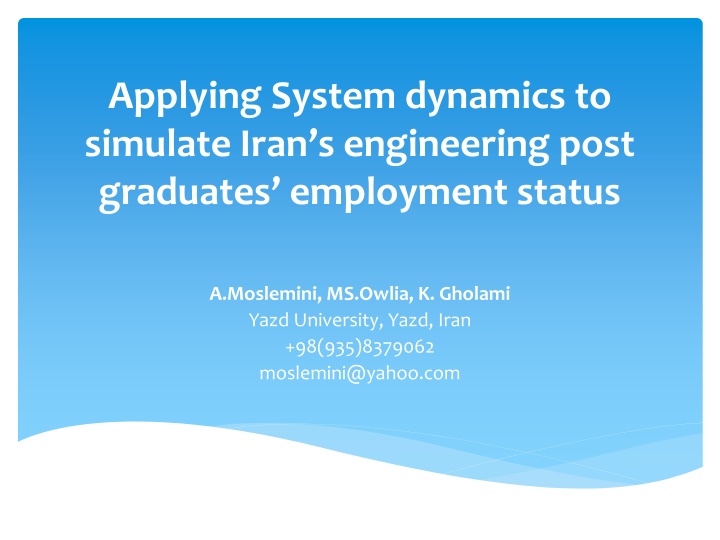
System Dynamics Simulation of Iran's Engineering Post Graduates Employment
Explore a research on modeling Iran's engineering post-graduates' employment status using system dynamics. Analyze the country's market capacity and the number of engineering graduates to predict future employment trends. Understand the challenges of graduates' unemployment and underemployment in Iran's higher education system.
Download Presentation

Please find below an Image/Link to download the presentation.
The content on the website is provided AS IS for your information and personal use only. It may not be sold, licensed, or shared on other websites without obtaining consent from the author. If you encounter any issues during the download, it is possible that the publisher has removed the file from their server.
You are allowed to download the files provided on this website for personal or commercial use, subject to the condition that they are used lawfully. All files are the property of their respective owners.
The content on the website is provided AS IS for your information and personal use only. It may not be sold, licensed, or shared on other websites without obtaining consent from the author.
E N D
Presentation Transcript
Applying System dynamics to simulate Iran s engineering post graduates employment status A.Moslemini, MS.Owlia, K. Gholami Yazd University, Yazd, Iran +98(935)8379062 moslemini@yahoo.com
Introduction during recent decades, students admission in Iran s universities had not been in line with country s market s needs for academic human resources [1]; a fact which has led to problems such as lack of experts in some fields and excess of them in many others. Graduates unemployment and under employment are the most vivid results stemming from this problem. In this research, we simulated Iran s market s future capacity for engineering post graduates from one side and the number of engineering PhD graduates, PhD students and master graduates from the other side to make it possible to predict post graduates employment status in country s near future.
SDs application in modeling educational systems advantages for using SD to model higher educational systems: Model feedbacks or interactive views in dynamic systems like higher education Incorporate non-linear relationships inherent in higher educational quality issues Address complexity situations while experimenting their behavior over time Accommodate soft factors that underpin higher education quality issues
Reference modes PhD engineering graduates vs. university and industry s capacity 35 30 industry's capcity 25 thousand person 20 University's capcity 15 10 phd grads 5 0 2006 2007 2008 2009 2010 year
Reference modes Fig3. Master engineering graduates vs university and industry s capacity 120 100 80 thousand person master grads 60 40 industry's capacity 20 0 2006 2007 2008 year 2009 2010
Engineering students admission and graduation sub system
Capacity for engineering post graduates Market University
Post graduates employment status sub system
Model Validation Model s Error rate Actual( ?) Simulated( ?) Variable Error rate Industry s capacity growth rate 1046987 1046882 0.0001 ? ? ? ????????? = growth rate of jobs that require a PhD degree 2155.54 2156.4 0.0004 growth rate of jobs that require a master degree 9393.3949 9412 0.002 growth rate of jobs that require a bachelor degree Master students graduation rate Bachelor students Graduation rate 102891 102823 0.0007 2279.435 2175.5 0.0478 10737.14 10671.75 0.0061
Results Fig8. PhD graduates employment status
Results Fig9. Phd students employment status
Results Fig10. Master graduates employment status
Discussion there will be enough job opportunities for engineering PhD graduates in both university and industry preventing them from jobs with lower academic degrees or becoming unemployed in onward years. there will always be enough job offerings from universities to let a considerable percent of engineering PhD graduates to be employed as professors. most engineering master graduates should be relegated to jobs requiring less knowledgeable workers (under employment). Recommendations to improve Master graduates future: Increase the growth rate of knowledge intensive jobs in country s industry. Decrease admission rate of higher education in master s degree; to adapt number of Master graduates to existing master degree requiring job opportunities in Iran s industry.
